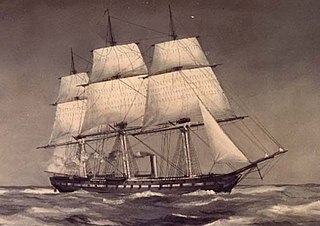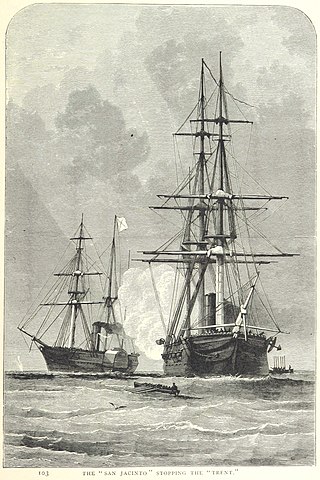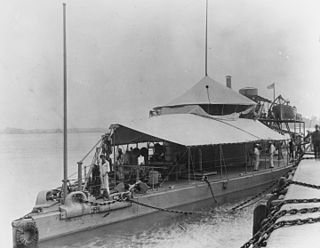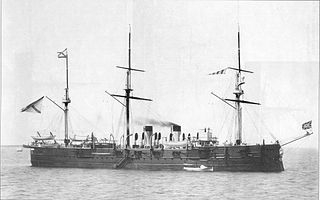
HMS Cornwall was one of 10 Monmouth-class armoured cruisers built for the Royal Navy in the first decade of the 20th century. She was assigned to the 2nd Cruiser Squadron of the Channel Fleet on completion in 1903. The ship was refitted in 1907 in preparation for service as a training ship for cadets with the 4th Cruiser Squadron on the North America and West Indies Station beginning in 1908.
USS Agamenticus was one of four Miantonomoh-class monitors built for the United States Navy during the American Civil War. Commissioned as the war was ending in May 1865, the ironclad saw no combat and was decommissioned in September and placed in reserve. The ship was reactivated in 1870, having been renamed Terror the previous year, and was assigned to the North Atlantic Fleet where she served in the Caribbean Sea. The monitor was decommissioned again in 1872 and was sold for scrap two years later. The Navy Department evaded the Congressional refusal to order new ships by claiming that the Civil War-era ship was being repaired while building a new monitor of the same name.

USS Dorothea L. Dix (AP-67) was a transport ship of the United States Navy named for American activist Dorothea Dix (1802–1887).

The second USS Macedonian, was a three-masted, wooden-hulled sailing frigate of the US Navy, carrying 36 guns. Rebuilt from the keel of the first Macedonian at Gosport Navy Yard, Portsmouth, Virginia beginning in 1832, the new Macedonian was launched and placed in service in 1836, with Captain Thomas ap Catesby Jones in command.

USS Wabash was a steam screw frigate of the United States Navy that served during the American Civil War. She was based on the same plans as Colorado. Post-war she continued to serve her country in European operations and eventually served as a barracks ship in Boston, Massachusetts, and was sold in 1912.

The first USS San Jacinto was an early screw frigate in the United States Navy during the mid-19th century. She was named for the San Jacinto River, site of the Battle of San Jacinto during the Texas Revolution. She is perhaps best known for her role in the Trent Affair of 1861.

The first USS Ossipee was a wooden, screw sloop-of-war in commission in the United States Navy at various times between 1861 and 1889. She served in the Union Navy during the American Civil War. She was named for the Ossipee River of New Hampshire and Maine. The USS Ossipee was present during the Alaska Purchase.

USS Ajax, originally named USS Manayunk after a town in Pennsylvania, was a single-turreted Canonicus-class monitor built for the Union Navy during the American Civil War. Completed after the end of the war, Ajax was laid up until 1871, although she received her new name in 1869. The ship was briefly activated in 1871, before a much longer commission began in 1874–1875. She was assigned to the North Atlantic Squadron during this time. Ajax was again placed in reserve in 1891. The ship was on militia duty when the Spanish–American War began and she was recommissioned in 1898, to defend Baltimore, Maryland, although she was decommissioned later in the year before the necessary refit could be completed. Ajax was sold for scrap in 1899.

HMS Decoy was a D-class destroyer of the Royal Navy. Ordered in 1931, the ship was constructed by John I. Thornycroft & Company, and entered naval service in 1933. Decoy was initially assigned to the Mediterranean Fleet before she was transferred to the China Station in early 1935. She was temporarily deployed in the Red Sea during late 1935 during the Abyssinia Crisis, before returning to her duty station where she remained until mid-1939. Decoy was transferred back to the Mediterranean Fleet just before the Second World War began in September 1939. She briefly was assigned to West Africa for convoy escort duties in 1940 before returning to the Mediterranean. The ship participated in the Battles of Calabria without significant damage and escorted ships of the Mediterranean Fleet for most of the rest of the year.

USS Concord was a member of the Yorktown class of steel-hulled, twin-screw gunboats in the United States Navy in the late 19th and early 20th centuries. She was the second U.S. Navy ship named in honor of the town of Concord, Massachusetts, site of the Battle of Concord in the American Revolutionary War.

HMS Drake was the lead ship of her class of armoured cruisers built for the Royal Navy around 1900. She was assigned to several different cruiser squadrons in home waters upon completion, sometimes as flagship, until 1911 when she became the flagship of the Australia Station. Upon her return home, she was assigned to the 6th Cruiser Squadron of the 2nd Fleet and became the squadron's flagship when the fleet was incorporated into the Grand Fleet upon the outbreak of the First World War.

HMS Leviathan was one of four Drake-class armoured cruisers built for the Royal Navy around 1900. She was assigned to the China Station upon completion and then served in the Mediterranean Fleet in 1905–06. She was assigned to the 7th Cruiser Squadron in 1907 before she was briefly reduced to reserve. Leviathan was recommissioned in 1909 for service with the 4th Cruiser Squadron before she was placed in reserve in 1913.

HMS Berwick was one of 10 Monmouth-class armoured cruisers built for the Royal Navy in the first decade of the 20th century. She was assigned to the 2nd Cruiser Squadron of the Channel Fleet upon completion in 1903 and was transferred to the Home Fleet in 1906. She accidentally rammed and sank a British destroyer in 1908. Berwick was refitted in 1908–09 before she was transferred to the 4th Cruiser Squadron on the North America and West Indies Station later that year.

HMS Cumberland was one of 10 Monmouth-class armoured cruisers built for the Royal Navy in the first decade of the 20th century. She was assigned to the 2nd Cruiser Squadron of the Channel Fleet upon completion in 1903. After a refit in 1907–1908 she became a training ship in the Home Fleet. She was sent to West Africa after the beginning of World War I in August 1914 and captured 10 German merchant ships in September. Cumberland spent the rest of the war on convoy escort duties and patrolling for German commerce raiders. She was sold for scrap in 1921 and broken up two years later.

HMS Lancaster was one of 10 Monmouth-class armoured cruisers built for the Royal Navy in the first decade of the 20th century. Upon completion she was assigned to the 3rd Cruiser Squadron of the Mediterranean Fleet. She remained there until 1912 when she returned home to be placed in reserve. The ship was recommissioned in 1913 for service with the 4th Cruiser Squadron on the North America and West Indies Station. She remained there until she was assigned to the Grand Fleet in 1915. She was transferred to the Pacific in 1916 and she became flagship of the Eastern Squadron in 1918. The ship was sold for scrap in 1920.

USS Arcturus (AF-52) was an Alstede class stores ship stores ship acquired by the U.S. Navy. Her task was to carry stores, refrigerated items, and equipment to ships in the fleet, and to remote stations and staging areas.

The French cruiser Gloire was one of five Gloire-class armored cruisers built for the French Navy in the first decade of the 20th century. Fitted with a mixed armament of 194-millimeter (7.6 in) and 164.7-millimeter (6.5 in) guns, the ships were designed for service with the fleet. Completed in 1904, Gloire joined her sister ships in the Northern Squadron, usually serving as a flagship. She participated in the French bombardment of Casablanca, Morocco, in 1907, and was briefly assigned to the Mediterranean Squadron in 1910–1911. Gloire became a training ship in late 1913.
USS Shepherd Knapp was a large (838-ton) ship with eight guns, purchased by the Union Navy during the beginning of the American Civil War.

SS West Mahomet was a steel–hulled cargo ship which saw service as an auxiliary with the U.S. Navy in 1918–19.

The Russian cruiser Minin was an armored cruiser built for the Imperial Russian Navy during the 1860s and 1870s. She was renamed Ladoga in 1909 when converted to a minelayer. The ship was sunk in 1915 when she struck a mine laid by a German submarine in the Baltic Sea.

















